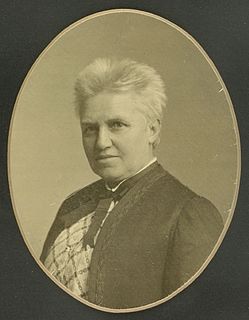
Fredrik Bajer was a Danish writer, teacher, and pacifist politician who received the Nobel Peace Prize in 1908 together with Klas Pontus Arnoldson.

The Danish Center for Research on Women and Gender (KVINFO) is a center that primarily aims to provide the general public with information about the results of women's studies and gender research undertaken in Denmark and internationally. KVINFO is an abbreviation of the Danish words køn, viden, information, and forskning, meaning gender, knowledge, information, and research.

Marie Sørine Louise Nørlund (1854–1919) was a Danish feminist and pacifist. She was the founder and chairman of the Danske Kvindeforeningers Valgretsforbund or DKV in 1898–1907 and 1908–1909.

Line Luplau (1823-1891) was a Danish feminist and suffragist. She was the co-founder of the Danske Kvindeforeningers Valgretsforbund or DKV and first chairperson in 1889-1891.

The modern-day character and the historical status of women in Denmark has been influenced by their own involvement in women's movements and political participation in the history of Denmark. Their mark can be seen in the fields of politics, women's suffrage, and literature, among others.

Nielsine Nielsen was the first female academic and physician in Denmark. She graduated in 1885 and in 1889 she established her own medical practice and worked as a general practitioner. She was active in the gender equality movement through her work in Danish Women's Society.

Henriette Marie Antonette Luplau was a Danish artist and educator, active in the women's movement. She conducted an art school for women in Copenhagen with her partner, artist Emilie Mundt.

Anna Olivia Nielsen, née Christensen, (1852–1910) was a Danish trade unionist and politician. Under her leadership, the Kvindeligt Arbejderforbund i Danmark gained prominence as agreements resulted from effective strike action. In 1901, the organization gained national status as the KAD, which Nielsen chaired until her death in 1910.

Helga Charlotte Norrie, née Harbou, was a Danish nurse, women's rights activist and educator. She was a major contributor to the development of nursing as an acceptable profession for women and also campaigned for women's rights, especially voting rights.
This is a timeline of women in Denmark, noting important events in Danish women's history.´

The Women's Exhibition from the Past and Present held in Copenhagen in 1895 was an art and culture exhibition for women from the Nordic countries. Inspired by the 1893 World's Fair in Chicago, it was designed to demonstrate how far Nordic women had advanced in the areas of education, employment and art. The first of its kind in Europe, it was considered a great success.

Jutta Bojsen-Møller born Bojsen (1837–1927) was a Danish high school proponent, a women's rights activist and a member of the Danish Women's Society which she headed from 1894 to 1910.

Clara Sophie Tybjerg née Sarauw (1864–1941) was a Danish women's rights activist, pacifist and educator. In 1915, she attended the International Women's Conference in The Hague, together with Thora Daugaard. Thereafter she helped establish and, from 1916 to 1920, headed the Danske Kvinders Fredskæde or Danish Women's Peace Chain which became the Danish branch of the Women's International League for Peace and Freedom. She is also remembered for helping to bring hunger-stricken children from Vienna to Denmark after the First World War.
Johanne Elisabeth Münter née Johnson (1844–1921) was a Danish writer and women's rights activist. After travelling to Japan with her husband in 1895, she wrote several books on Japanese women and her own fascination with the country. In the 1890s, she became involved in the women's movement, speaking about culture and religion at the Kvindelig Læseforening. She also joined the Danske Kvinders Forsvarsforening and the women's department of the Red Cross. In 1904, she participated in the founding conference of the International Woman Suffrage Alliance (IWSA) in Berlin. In 1906, she founded and headed the women's suffrage organization Kvindevalgretsklubben which was a member of the Danske Kvindeforeningers Valgretsforbund. She was a delegate at the IWSA conferences in Amsterdam (1908) and London (1909).

Johanne Marie Abrahammine Meyer née Petersen (1838–1915) was a Danish suffragist, pacifist and journal editor. A pioneering member of various women's societies, from 1889 she served on the board of the pacifist organization Dansk Fredsforening and became the influential president of the progressive suffragist organization Kvindelig Fremskridtsforening (KF). From 1888, Meyer was editor of KF's journal Hvad vi vil, to which she contributed many articles.

The Danske Kvindeforeningers Valgsretsudvalg was established in 1898 by Louise Nørlund, with support from Line Luplau, in order to work towards obtaining the vote for women. In 1904, the organization's name was changed to Danske Kvindeforeningers Valgretsforbund (DKV) or the Danish Women's Society's Suffrage Union.
The Kvindelig Fremskridtsforening (KF), or Women's Progress Association, was a Danish women's association which was founded in 1885 by Matilde Bajer and Elisabeth Ouchterlony. They had both been co-founders of the Danish Women's Society in 1871 but now wanted an organization which included specific attention to women's suffrage in municipal and national elections, an issue which was not on the agenda of the apolitical Women's Society. The organization also addressed women's involvement as peace activists and as members of the workforce.

Vibeke Ingeborg Salicath née Frisch (1861–1921) was a Danish philanthropist, feminist and politician. From the 1890s, together with her sister Gyrithe Lemche, she was an active member of the Danish Women's Society where from 1901 she edited Kvinden & Samfundet.

Frida Frederikke Caroline Christiane Schmidt (1849–1934) was a Danish teacher, suffragist and a pioneering activist for the Danish Women's Society on the island of Funen. She helped to establish the Odense branches of both the Women's Suffrage Association in 1889 and the Women's Society in 1890. In the early 1890s, she was one of the strongest advocates for having women's voting rights adopted as part of the Odense organization's programme, years before the Women's Society included the right to vote in their national programme in 1906.
Merete Gerlach-Nielsen (1933–2019) was a Danish-born French-language academic, UNESCO's coordinating director for women's affairs (1988–1990), and one of the founders of Kvinfo, the Danish Centre for Research on Women and Gender. In 1998, she chose to adopt French citizenship.
















